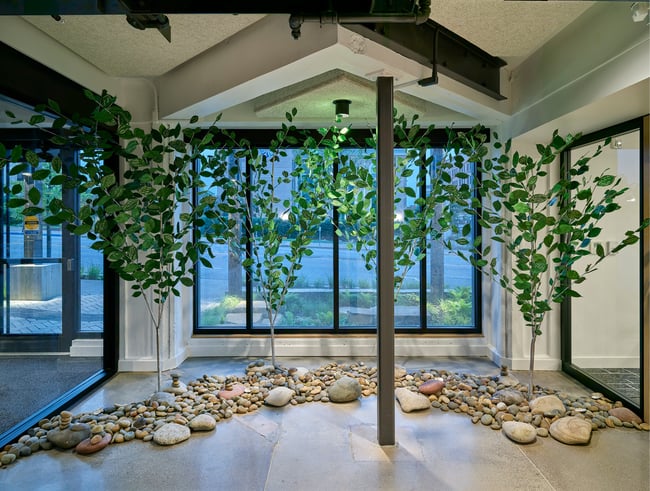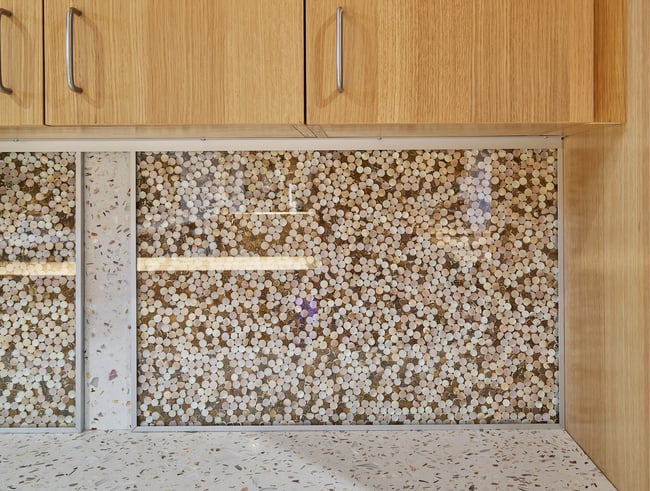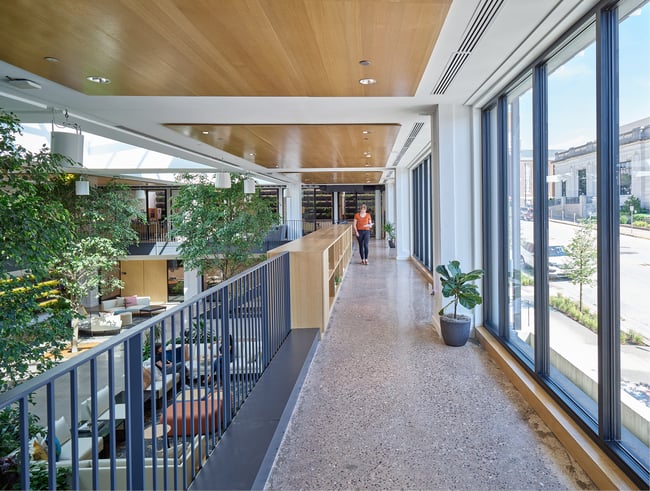Biophilia and Inspiration: LBC Beauty Petal at the Stanley Center

Discussions about sustainability often focus on building performance, systems, and energy consumption. While these elements are important, they tend to overshadow one of the key components of architecture: the experience of inhabiting a building.
Buildings should delight occupants—providing inspiration and enriching lives. A sustainably designed building falls short of its potential if it overlooks beauty.
The Living Building Challenge (LBC), a third-party building certification system, keeps the human experience at the heart of sustainable design. Its Beauty Petal encourages projects to explore biophilic design and find ways to connect the project to nature and place.
In Muscatine, Iowa, the Stanley Center for Peace and Security is tracking to become the second renovation to achieve a full Living Building Certification. To celebrate this achievement, we are discussing how the project fulfills each Petal of the LBC framework.
This article will focus on the Beauty Petal and explain how the Stanley Center meets its imperatives.
Understanding the Beauty Petal
The LBC is the most rigorous approach to sustainable design—addressing everything from energy consumption and water use to occupant well-being. Its framework is broken into seven categories known as Petals, which include:
- Place
- Water
- Energy
- Health and Happiness
- Materials
- Equity
- Beauty
The Beauty Petal asserts that access to beauty is a precursor to caring about the greater good. It envisions a future where buildings enrich our lives and restore our innate connection to nature.
Although beauty is subjective, the Petal sets a few requirements. It encourages project teams to explore biophilia—the practice of creating connections to nature within the built environment.
Specifically, the project should cultivate place-making and connect to the local climate, ecology, community, and culture. Projects should also include features dedicated solely to human delight, like artwork.
The Beauty Petal at the Stanley Center
Each LBC Petal is broken into separate requirements called imperatives for a total of 20. The Beauty Petal contains two:
- Beauty and Biophilia
- Education and Inspiration
The Stanley Center met these requirements by participating in an all-day workshop to explore biophilic design strategies. They have also created opportunities to educate the public about the building’s sustainable features.
Beauty and Biophilia
The intent of the Beauty and Biophilia imperative is to connect occupants to the benefits of biophilia. One of its requirements is an all-day Biophilic Exploration where project stakeholders explore how the project can incorporate environmental features and connect occupants to a sense of place.
The Stanley Center’s Biophilic Exploration included a local historian who explained the history of the building site—the former Musser Public Library—and the native tribes who inhabited the area originally. The exploration led to several goals which were incorporated into a framework to guide decision-making. Throughout the design process, the team referred to this framework to ensure biophilia remained central to the design.
One goal was to acknowledge the Meskwaki and Sauk people who inhabited the Muscatine area before European colonization. The Stanley Center incorporated educational signage about the history of the land, as well as a public art project called the Tree of Accountability.

The Tree of Accountability at the Stanley Center.
The artwork was a collaboration between Nancy Morris-Judd, an artist, and Deana Dartt, PhD, a Native American Consultant. Made from an old aluminum guardrail, the project seeks to create more meaningful connections between the Muscatine community and indigenous tribes.
The building contains several other elements that connect to Muscatine’s history. The kitchen backsplash, made from pearl button blanks, pays homage to the button industry that dominated the area in the first half of the 20th Century. White oak veneers found throughout the facility acknowledge Muscatine’s early logging industry.

The Pearl Button backsplash references Muscatine's industrial history.
Although plants, daylight, and exterior connect occupants to nature, the facility also features some less obvious examples of biophilic design. Its layout, for instance, represents the biophilic design concept of “prospect and refuge.”
Public spaces make up the first floor, while the second floor contains private offices. Occupants can look out over the first floor from their offices (prospect) while maintaining privacy from those below (refuge). The design connects to our innate desire to explore our surroundings while maintaining a sense of protection.

Second-floor offices look out over the public atrium.
Education and Inspiration
The Living Building Challenge is more than a certification system. It is also a philosophy and advocacy tool that seeks to change our approach to design and construction. As such, project teams should provide educational materials and opportunities to promote change.
The Education and Inspiration imperative sets several requirements, including:
- A publicly available project case study
- An annual open house
- A publicly available copy of the Operations and Maintenance Manual
- A brochure describing the design and environmental features of the project
- Interpretive signage that teaches visitors about the project
- An educational website
Since its opening, the Stanley Center has hosted several community events. Its Sustainability Fair—hosted in June 2023—included self-guided tours of the facility, with a brochure explaining the building’s sustainable features.
The Center also hosts weekly public open houses. Anyone is free to stop by and get a tour of the facility. Signage—soon to be complete—will provide visitors with a deeper understanding of the building’s systems, the site's history, and how it manages energy and water.
Learn More About the Living Building Challenge
The Beauty Petal helps center the human experience in sustainable design discussions. Its Biophilic Exploration leads to a framework for vetting decisions, helping project teams find ways to connect to place and nature throughout the design process.
For our team, the experience created a ripple effect. We have since explored ways to replicate the Biophilia Exploration for other clients and work biophilia into pre-design discussions.
Exploring ways to connect a project to nature, culture, and community is always worthwhile.
The Biophilia Exploration is one component of the LBC that requires a larger group commitment. More than most certification systems, the LBC encourages an inclusion process that engages everyday occupants. Learn more about the LBC process by reading about the questions to ask before pursuing.